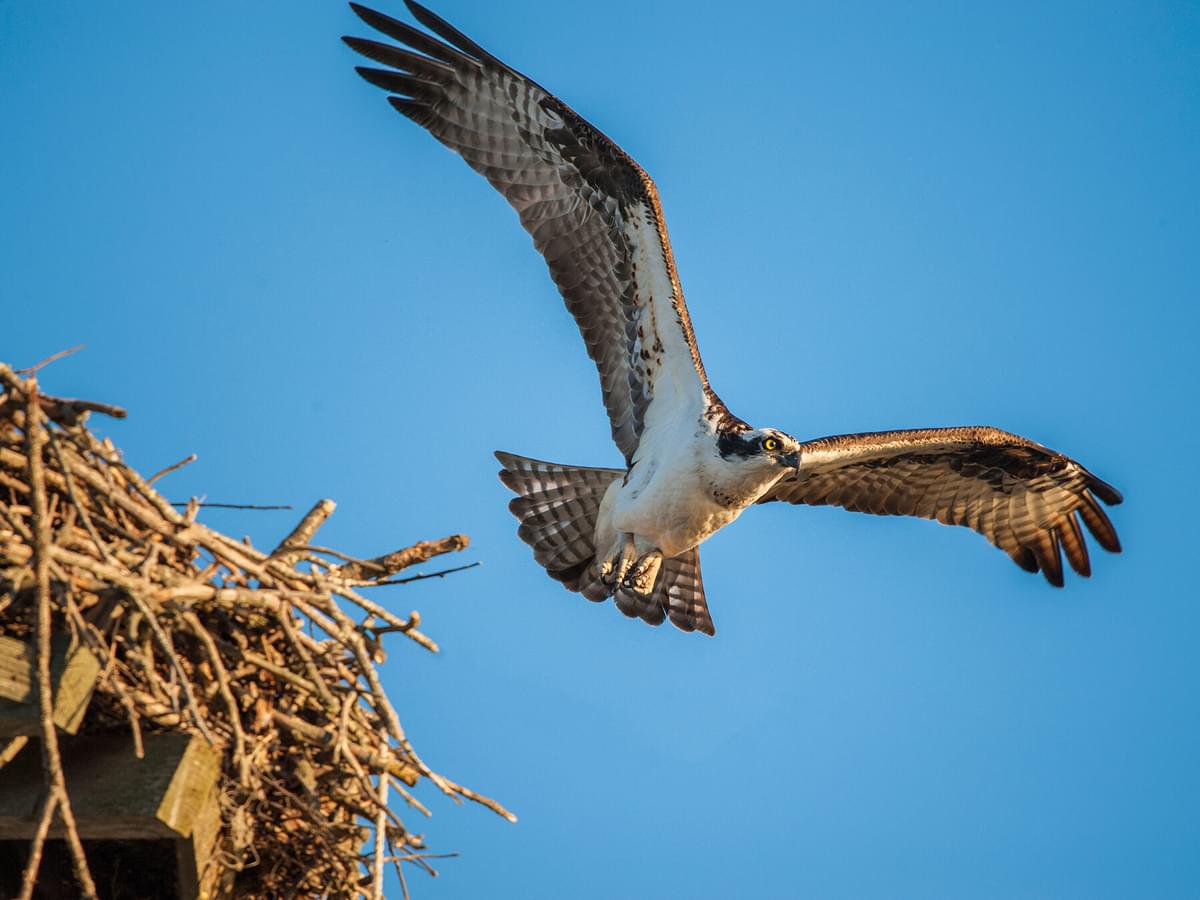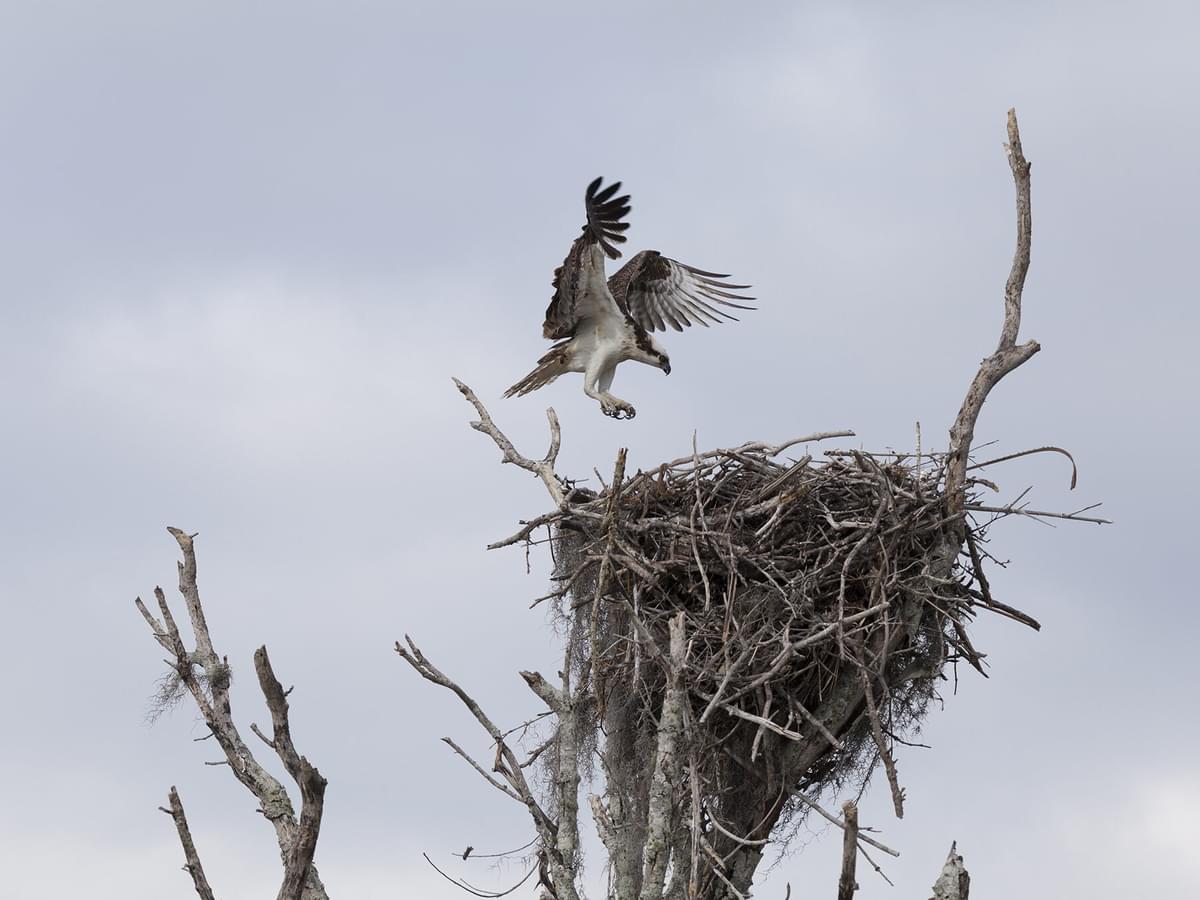Jump to Section
Osprey Nesting (All You Need To Know)
Last updated: 3 February 2023

Ospreys are common resident and migratory birds of prey that can be seen hunting over lakes, rivers, and coastal waterways all over the world. These successful raptors have perfected the art of teamwork and pairs of these majestic birds may return to the same nest year after year to raise new generations.
Ospreys (Pandion haliaetus) nest in the winter, spring, and summer months. Pairs mate for life, raising three young per season if all goes well. Osprey pairs work together to build a large stick nest on a tree, cliff face, or man-made structure. They each have their roles to play in incubating, brooding, and caring for their young.
Ospreys are a conservation success story. Caring individuals and groups of people have helped populations of these majestic birds of prey increase in numbers by providing them with the spaces they need to successfully nest and raise their young. Read this article to learn more about where, how, and when ospreys nest.
| Key Osprey Nesting Facts | |
|---|---|
| Nesting season | May to early September |
| Nesting material | Sticks |
| Nest type | Large, rounded |
| Nest location | Trees, cliffs, nesting platforms |
| Number of broods | One brood |
| Clutch size | 3 eggs, ranging from 1 - 4 |
| Egg color | Creamy white to pinkish, with dark spotting |
| Egg size | 60 x 45 mm |
| Egg weight | 72 g |
| Incubation period | 32 - 42 days, by both sexes, but female does the majority |
| Fledgling period | 50 days after hatching |
| Reuse nests | Where possible |
| Use nest boxes | No, but use nest platforms |

A male osprey feeding chicks fish in the nest
Where do ospreys nest?
Ospreys build their nests on top of or in trees, or on cliffs and other rocky structures. They will also readily use man-made platforms to build their nests. Artificial nest sites include purpose-built platforms to assist the birds and other structures like towers and poles.
The height of nest sites varies widely and they have been recorded at heights of 90m (300ft) on cliff faces. They will even build their nests on the ground in places where there are no predators to worry about.
Ospreys specialize in catching fish, which is why they are often known as fish hawks. Their nests are usually very close to the water but can be as much as 20 kilometers (12mi) from their hunting grounds. Read on to learn more about the osprey nest.

A pair of nesting ospreys during the breeding season
What do osprey nests look like?
When seen from below, osprey nests are rather untidy-looking rounded structures built mostly from sticks. Viewed from above, they contain many other materials, often including artificial items like plastic netting and even toys.
The Ospreys start with large sticks at the bottom, using smaller materials towards the top. Sticks don’t provide much insulation (or comfort) so the birds line their nest with soft materials like moss, grass, and seaweed.
How big are osprey nests?
Osprey nests vary in size depending on how old they are, and the shape and strength of the nesting site. Ospreys will continually add to the nest every year and they can become very large in time.
A newly built osprey nest usually measures at least 70cm (28in) across and up to 15cm (6in) deep. Much older nests of 4m (13ft) deep and 2m (6.5ft) across have been recorded, but this is only possible at very sturdy nest sites.

A large osprey nest high up in a tree
What time of year do ospreys nest?
Ospreys nest at different times of the year depending on their local climate. Ospreys from warmer areas tend to start earlier in the winter and spring. In colder regions, they tend to nest in the spring and summer months.
How long do ospreys nest for?
Ospreys have a relatively long nesting period. The total time varies according to a number of different factors but may take over 4 months from the time the pair begin nest construction to the time the young leave the nest.
It takes a pair of ospreys up to 3 weeks to build a new nest. They will begin egg-laying very soon after the nest has been completed. Pairs returning to an established nest can lay their eggs as soon as a week after arriving at the nest site.
The eggs are incubated for 34 to 42 days and begin cracking 2 to 3 days before the chicks hatch. From the time of hatching, the chicks may take as long as 2 months to fledge.

An osprey high up in their nest on a nesting platform
How do ospreys build their nests?
Both male and female ospreys are involved in nest building, but they each have different roles.
The male osprey is usually responsible for selecting the nesting site. Once chosen, he brings the majority of the nesting material in. He collects most of the sticks from the ground but some material is broken off from tree branches. The female osprey does the actual building, placing the material and shaping the nest into its final form.
Ospreys will continue to maintain their nest through the nesting period. Its shape tends to flatten out over the course of the breeding season, however. Interestingly, older chicks have been observed moving the nest material around in the nest and maintaining its perimeter.

An osprey bringing nesting materials for building the nest
When do baby ospreys leave the nest?
Baby ospreys first leave the nest 50 to 60 days after they hatch. They begin exercising their wings and even hovering briefly above the nest after about 40 days. They are not quite ready to fend for themselves after leaving the nest and continue to be fed by their parents for some time.
After fledging, the chicks will stay in the vicinity of the nest and continue to be fed by their parents. In non-migratory populations, the chicks have the luxury of sticking around for as long as 10 weeks, while the young of migratory birds from the north may be fed for as little as 10 days.
How many broods do ospreys have?
Ospreys have only one brood per year. The eggs take several weeks to hatch and the youngsters mature slowly, making a second brood impossible for the busy parents.

Female osprey feeding young chicks fish
Do ospreys nest in the same place every year?
Wherever possible, ospreys will nest in the same place each year. This saves the pair much time and effort, allowing them to breed earlier and ultimately, have a better chance of successfully raising their young.
Nests built at sturdy sites like platforms tend to last longer than those built at the tops of trees and can be used many times. The pair will often continue to add material to the nest each year, which is why some nests become so large.
What do osprey eggs look like?
Ospreys lay large, beautifully marked, and colored eggs. The ground color is a cream to pinkish shade and they are boldly marked with darker reddish-brown patches.
In North America, osprey eggs measure 61mm x 45.6mm on average. Interestingly, this is slightly smaller than the average size in Europe. The average mass of an osprey egg is about 66g (2.3oz), which is similar to an extra-large chicken egg.

Two Osprey eggs in the nest
What month do ospreys lay eggs?
Ospreys lay eggs in different months depending on the local climate and whether the birds are resident or migratory. In the United States, eggs are laid as early as November in Florida, but as late as May in New England. Nesting starts in April in the United Kingdom.
Do ospreys use nest boxes?
Ospreys do not use cavity-style nest boxes but that does not mean you can’t create a suitable nest site for them. Ospreys frequently make use of purpose-built nesting platforms.
The Tennessee wildlife resources agency provides one good example of a nest platform plan for ospreys.

Osprey chicks in the nest
Where do ospreys nest at night?
The female osprey typically incubates the eggs at night. While she is sleeping in the nest, the male will most likely be found perched on a branch nearby.
Do ospreys nest in backyards?
Very few people have backyards that can provide the appropriate nesting sites for ospreys. If, however, you have a large waterside property with a tall tree or suitable nesting platform, there’s every chance that an osprey pair could build their nest there.

An Osprey sitting on the nest
Do ospreys abandon their nests?
Ospreys do occasionally abandon their nests. This could be the result of a nest collapsing, the eggs or chicks being predated, or there being a lack of food in the area.
Nesting failure and abandonment are more likely with younger, less experienced parents. A pair that has abandoned a nest will occasionally begin to build a new nest for the next brood, but will not use it until the next year.
Osprey Nesting FAQs
What trees do ospreys nest in?
Ospreys nest in a wide variety of tree species depending on what occurs in their area. In tropical regions, mangroves are often used. In other regions, spruce, cypress, pines, junipers, and even large cacti are used.
Do ospreys nest on the ground?
Ospreys do occasionally nest on the ground but only where it is safe to do so. Inaccessible cliffs are one example, but islands, where there are no raccoons or other predatory mammals, are also safely used.
Do male ospreys sit on eggs?
Both male and female ospreys are responsible for incubating the eggs. Female ospreys spend more time incubating the eggs than males, however, and it is the female that incubates at night.
On this page
- Where do ospreys nest?
- What do osprey nests look like?
- How big are osprey nests?
- What time of year do ospreys nest?
- How long do ospreys nest for?
- How do ospreys build their nests?
- When do baby ospreys leave the nest?
- How many broods do ospreys have?
- Do ospreys nest in the same place every year?
- What do osprey eggs look like?
- What month do ospreys lay eggs?
- Do ospreys use nest boxes?
- Where do ospreys nest at night?
- Do ospreys nest in backyards?
- Do ospreys abandon their nests?
- Osprey Nesting FAQs




